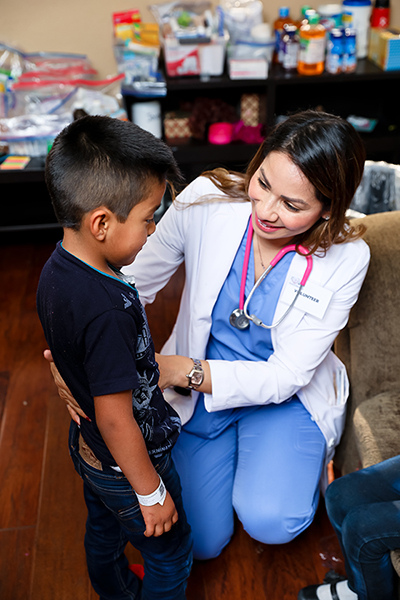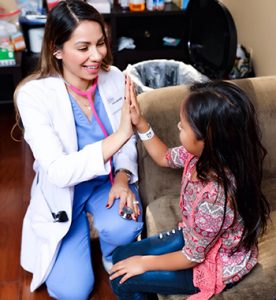PAs Deliver Health Care to U.S. Asylum-Seeking Immigrant Families
Underserved Communities Rely on Volunteers
February 12, 2019
By Elizabeth Lopez-Murray, DHEd, PA-C, MSPAS, MPH

PAs and other medical providers are part of teams providing care to immigrants in Arizona seeking asylum, often purchasing medications with their own funds. I have been privileged to be part of this group of volunteers providing humanitarian assistance.
Humanitarian crisis at the border
For the past four years, Central America has been faced with a humanitarian crisis that has received global attention. Extreme violence, poverty, and persecution are plaguing thousands of people living in Central America. Now, individuals from Guatemala, Honduras, and El Salvador, are seeking asylum in the United States in staggering numbers (Bermeo, 2018; Cara & Renwick, 2018).
These regions, known as the Northern Triangle of Central America, consistently rank among the most violent countries in the world, forcing desperate families to flee with children, some of whom are only infants (Cara & Renwick, 2018; William, 2017). With gang violence having exceeded the capacity of government there is very little governmental protection, leaving families with no choice but to take desperate measures to protect their lives and their children’s (Cara & Renwick, 2018). In some cases, children make this perilous journey alone.
In 2016, according to U.S. Customs and Border Protection, a total of 59,692 unaccompanied children and 77,674 families sought asylum at the U.S. border. These numbers have continued to increase. In Guatemala, for instance, the United Nations Office for the Coordination of Humanitarian Affairs (OCHA) reports that chronic malnutrition affects one out of two children under the age of five, leading to irreversible mental, physical, and cognitive damage. There is still work to be done to determine the social and emotional impacts of the journey and subsequent detention of these children and families.
Asylum-seeking families have arrived in Arizona
Federal government detention centers are unable to accommodate the increased number of asylum seekers at various ports of entry across the United States. As a result of overcrowding, U.S. Immigration and Customs Enforcement (ICE) has been forced to release asylum-seeking migrants all along the southwest border. In Phoenix, Arizona, Magdalena Schwartz, a community leader and pastor, has worked tirelessly to unify various churches. Her efforts have resulted in open doors and a variety of humanitarian assistance ranging from food and clothing to medical care.
Churches respond to the humanitarian crisis
Prior to Schwartz’s involvement, many families were abruptly released into the community without any instruction on where to go or how to find relatives. Some were even dropped off at bus stops, leaving them homeless. Without money, cell phones, or information on how or where to go, they were helpless in an unfamiliar country. Graciously, multiple churches began opening their doors to these families. These churches have now welcomed over 12,000 immigrants since October 2018, but Schwartz notes that ICE buses continue to drop off over 100 immigrant families each day, many with multiple children and only the clothes on their backs.
Upon arrival to the churches, families and children are greeted with warmth and compassion. Children are given a small stuffed animal to help them feel safe and bring a bit of joy to their lives. Witnessing the fear on a child’s face transform into a smile melts the heart of every individual involved. These volunteers and donors provide warm showers, hot meals, clothing, shoes, toiletries, medical care, and shelter. Volunteer services range from assisting families with travel arrangements to hosting families until it’s time to travel to their final destination, most often to a family member who has already immigrated.
In my own volunteer work, I’ve seen many dehydrated and seriously ill children arrive at the churches. Some are so ill that they are sent to be treated at the emergency room. I personally examined a two-year-old girl who had only eaten juice and crackers for the past two weeks. This child’s abdomen was so severely distended she was immediately transported to Phoenix Children’s Hospital for further evaluation. I also examined a five-year-old boy with a leg laceration from crawling under barbed-wire fence in the desert. Five days after the wound was cleaned, stapled, and covered at the emergency room, his mother mentioned that she was too scared to remove the gauze and had not seen the wound since the staples were placed. Nor did she know who or when the staples would be removed from the child’s leg.
[Africa Calls PAs: Providing Medical Care on the Continent]

Health concerns for immigrant families and children
Dropping temperatures across the country have posed serious health concerns for immigrant families and their children. The recent deaths of two migrant children have only added concerns about the health of these children and families when they arrive at the detention centers. Many refugees have noted that the conditions at the detention center are more traumatizing than the journey. Many families slept on cold cement floors, kept at unbearably cold temperatures. Sometimes children would not eat due to lack of food. Others noted that they were kept in cold temperatures to keep the scent of being unable to shower tolerable for detention workers. Given these conditions, some people were not surprised when, in 2018, one child died of complications from influenza and another from dehydration and shock.
Many other children have tested positive for influenza and have been prescribed medication. However, due to lack of money parents are unable to pay for the medication. This issue poses an even greater health issue since migrant families are typically housed in closed quarters with each other and influenza is so rampant. To help combat this issue, a medical team consisting of medical doctors, PAs, nurse practitioners, and nurses volunteer to provide medical care to migrant families often using our own funds to purchase the necessary medications. The most common illnesses treated include upper respiratory infections, otitis media, fevers, diarrhea, fungal infections, and wound care.
Charities such as 100 Angels notify medical volunteers via text message on locations ICE will be releasing refugees. Many donors have donated Tylenol and Ibuprofen, cold and cough medications, antibiotics, and Pedialyte.

A desire to help
Before I became a PA, I volunteered once a month in Tijuana, Mexico, for a poverty relief agency in Pacoima, California. There were many impoverished communities that lacked access to basic healthcare and relied on volunteer-run free clinics. Through my volunteering, my interest in the medical profession grew and I became passionate about helping those in need. As a volunteer, I took patient vitals but became frustrated with my limited medical knowledge and skills. I worked alongside inspirational PA mentors and witnessed the love and compassion they had for their patients. The experience and exposure sparked my interest and I began to shadow PAs. The PAs I worked with motivated me to return to school and become a PA myself.
[‘Lost Boy of Sudan’ Devoted to Helping Others as PA]
During my second year of PA school, I had the opportunity to do a clinical rotation in the underserved village of San Lucan Toliman, Guatemala. This experience further strengthened my passion for working and volunteering with underserved communities and populations. Now that I’m a practicing PA, I am able to be on the forefront and provide the necessary medical care for my patients. I am currently working in a family practice that is in an underserved community and, during my spare time, I volunteer at different churches providing medical care for immigrant families seeking asylum.
My experience is only a snapshot of the crisis. We live in a world where there are many impoverished communities that lack access to medical care. As a practicing PA, I want to continue devoting my time to assist those most in need and hope that more PAs will be inspired to work in underserved communities. I have never been prouder to be a healthcare provider. With dignity and respect, we will continue to provide humanitarian assistance to families in need. In our eyes, this is a human issue and goes far beyond politics. It is about human beings helping humans.
More Resources
PAs for Global Health
Elizabeth Lopez-Murray, PA-C, DHEd, MSPAS, MPH, lives in in Scottsdale, Arizona, and can be reached at [email protected].
References
Bermeo, Sarah. (2018). Violence Drives Immigration from Central America. Retrieved January 6, 2019 from https://www.brookings.edu/blog/future-development/2018/06/26/violence-drives-immigration-from-central-america
Cara, L., Rocio, Renwick, Danielle. (2018). Central America’s Violent Northern Triangle. Retrieved January 5, 2019 from https://www.cfr.org/backgrounder/central-americas-turbulent-northern-triangle
Kandel, A. William. (2017). Unaccompanied Alien children: An Overview. Retrieved January 5, 2019 from https://fas.org/sgp/crs/homesec/R43599.pdf
UN Office for the Coordination of Humanitarian Affairs. (2017). Guatemala Humanitarian Needs Overview at a Glance. Retrieved January 5, 2019 from https://reliefweb.int/report/guatemala/2017-guatemala-humanitarian-needs-overview-glance-nov-2017
U.S. Customs and Border Protection. (2016). United States Border Patrol Southwest Family Unit Subject and Unaccompanied Alien Children Apprehension Fiscal Year 2016. (2016). Retrieved January 5, 2019 from https://www.cbp.gov/newsroom/stats/southwest-border-unaccompanied-children/fy-2016
Thank you for reading AAPA’s News Central
You have 2 articles left this month. Create a free account to read more stories, or become a member for more access to exclusive benefits! Already have an account? Log in.



